Riparian
Floodplain Vegetation, and Swamps--
A great variety of hydrophytes occur on floodplains and riparian zones
that are inundated seasonally, and an annual period of flooding –
which may last several months – is essential for their health. Such
species may be confined to riparian sites. Most terrestrial plants die
when submerged for any length of time, but many floodplain plants exist
in a terrestrial and an aquatic form. In most cases, the best adapted
plants are grasses with stems that can grow extremely fast during rising
floods to keep the leaves and flowers above the water. A number of extremely
productive species of 'reeds' (Lepironia, Phragmites, Typha)
and grasses (Paspalum, Echinochloa, Vossia) occur
on floodplains, species in the latter group sometimes forming floating
meadows or 'grass islands' in floodplain backwaters and lateral lakes.
Sedges (Cyperaceae) are especially diverse in floodplain habitats. Although
many riverine hydrophytes are non-woody herbs, especially grasses and
sedges, they include also a variety of trees; in particular, those that
constitute swamp and peatswamp forest.
Some floodplain hydrophytes are of great importance to humans. Rice is
the most familiar example. One subspecies known as Deep-water rice (Oryza
sativa indica) grows on floodplains during the wet season in water
0.5 – 3.5 m deep. The rice is adapts to flooding by elongating the stems
as the water level rises; it can also tolerate short periods of complete
submergence. The total area covered by this plant is by far the largest
of any aquatic macrophyte in the world, but little is known about the
ecology of this plant – or almost any other Asian hydrophyte – and its
influence on the floodplain habitat.
Much of the Mekong delta (i.e., downstream of Phnom Penh) is under rice
cultivation, including the 'Plain of Reeds' on the Cambodia-Viet Nam border.
Some natural vegetation remains however, including patches of Melaleuca
(Myrtaceae) inundation forest, as well as areas of open water with lotus
and water lilies, and wet grassy plains dominated by the sedges (Eleocharis
spp.). Wild rice (Oryza rufipogon), which can occur rooted or in
floating grass mats, also grows in this region.
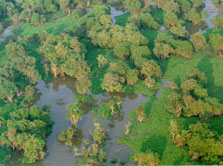 |
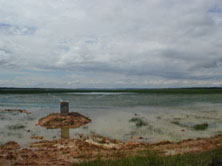 |
Riparian vegetation refers to plants that line the banks of rivers and other inland water bodies. It protects the bank from wave action and offers shelter, feeding and breeding areas for fish, birds and other organisms. The riparian zone contains a variety of plants of differing growth form. There is a gradual transition in vegetation, reflecting differing tolerances for waterlogging, as distance from the bank increases.
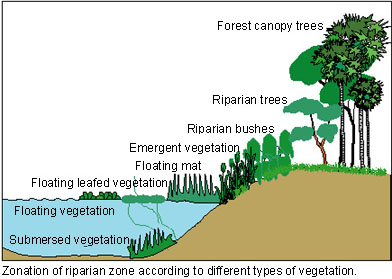 |
As a rough generalization, short grassland
dominates marshy areas of floodplains that have relatively well-drained
mineral soil, are some distance from the river channel, and are flooded
for only a short time each year. Swamps (including peatswamps) occur closer
to the river channel where the soils are frequently waterlogged, highly
leached and lacking in calcium. They may be dominated by single stands
of tall grass (e.g., Phragmites) or sedges, or by forest.
Swamps can be divided into two categories. Topogenic swamps have a shallow
(<50 cm) accumulation of organic material and are flooded by river
water in the wet season. Some scientists classify them as 'riparian-inundation
forest'; they have been cleared over large parts of their range in Southeast
Asia and in the Mekong Basin. Ombrogenous swamps are 'true' peat swamps
with accumulations of organic matter >50 cm thick which may reach 20
m deep. Water drains outward from the centre of the peatswamp dome to
the perimeter, flowing into a series of blackwater streams (with water
stained brown like tea by chemicals from the peat), which empty into rivers
fringed with swamp forest. Peatswamp forest is usually flooded to depths
of 1 m or more during the wet season, and may remain inundated for up
to eight months.
Despite seasonal floods and waterlogged soils, swamp forests support a
diverse flora including species found in no other habitat. Some are of
commercial importance (e.g., Gonystylus bancanus: Thymelaeaceae).
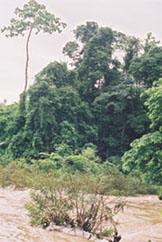 Community
composition varies. Mixed species-rich forests occur on swamp peripheries
along river margins. In addition to the Melaleuca mentioned above
(see also section on Mangroves), some of these seasonally-inundated forests
are dominated by Eugenia spp. (Myrtaceae) and Pandanus helicopus
(Pandanaceae), while assemblages along the Mekong floodplain and shores
of The Great Lake are characterised by Barringtonia spp. (Lecythidaceae),
Homalium brevidens and Hydnocarpus anthelminthica (Flacourtiaceae).
Forests in the centre of peatswamps are typically composed of relatively
few species – usually members of the dipterocarp genus Shorea.
Community
composition varies. Mixed species-rich forests occur on swamp peripheries
along river margins. In addition to the Melaleuca mentioned above
(see also section on Mangroves), some of these seasonally-inundated forests
are dominated by Eugenia spp. (Myrtaceae) and Pandanus helicopus
(Pandanaceae), while assemblages along the Mekong floodplain and shores
of The Great Lake are characterised by Barringtonia spp. (Lecythidaceae),
Homalium brevidens and Hydnocarpus anthelminthica (Flacourtiaceae).
Forests in the centre of peatswamps are typically composed of relatively
few species – usually members of the dipterocarp genus Shorea.
Upstream of the floodplain in the main lowland course of the Mekong, flows
are relatively slow in the dry season but become torrential in the flood
season when waters may rise 10 m. Much of the riverine forest has been
cleared, but remnants include trees such as Dipterocarpus altus,
D. dyeri and Hopea odorata (Dipterocarpaceae). Adaptations
for dealing with the floods include growing near horizontally, or development
of structural supports on the downstream side of their trunks (Edwards,
2001). Bushes, typically Homonoia riparia (Euphorbiaceae), which
grow among rocks and on sandbars in braided channels, can survive prolonged
immersion during the wet season.
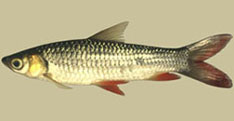 Some
species of riverine tree have evolved in association with the elements
of the fauna such as fish and monkeys to the extent that the tree species
is totally dependent on the fish or mammal to disperse its seeds. One
Mekong example is Leptobarbus hoeveni (Cyprinidae), known as the
'mad fish', which waits under Hydnocarpus trees for the fermented
fruits to fall. The fish eats the fruit and disperses the seeds, but the
fermented flesh '… soon renders the fish drunk and schools can be
seen floating helplessly in the water …' (Banarescu and Coad 1991).
Eating the flesh of the fish when it is in this condition causes humans
to become nauseous. Other fruits from flooded forest eaten by Mekong fishes
include species in the genera Allophyllus, Ardisia, Artabotrys, Eugenia,
Ficus, Morindopsis, Olax, Physalis and Quassia (Roberts 1993).
Some
species of riverine tree have evolved in association with the elements
of the fauna such as fish and monkeys to the extent that the tree species
is totally dependent on the fish or mammal to disperse its seeds. One
Mekong example is Leptobarbus hoeveni (Cyprinidae), known as the
'mad fish', which waits under Hydnocarpus trees for the fermented
fruits to fall. The fish eats the fruit and disperses the seeds, but the
fermented flesh '… soon renders the fish drunk and schools can be
seen floating helplessly in the water …' (Banarescu and Coad 1991).
Eating the flesh of the fish when it is in this condition causes humans
to become nauseous. Other fruits from flooded forest eaten by Mekong fishes
include species in the genera Allophyllus, Ardisia, Artabotrys, Eugenia,
Ficus, Morindopsis, Olax, Physalis and Quassia (Roberts 1993).